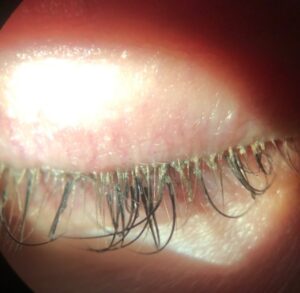Diagnosing DED? Don’t forget to check the eyelids too
The contents of this article are informational only and are not intended to be a substitute for professional medical advice, diagnosis, or treatment recommendations. This editorial presents the views and experiences of the author and does not reflect the opinions or recommendations of the publisher of Optometry 360.
By Jade Coats, OD, FAAO
“Why hasn’t anyone told me this before?” It’s a question I hear all too often when I diagnose blepharitis—even in patients who have been treated repeatedly for dry eye disease (DED). The truth? DED is so prevalent that it often overshadows other potential contributors, leading doctors to focus on symptom relief rather than addressing the underlying eyelid issues. Yet untreated blepharitis can sabotage DED treatment, impacting symptom chronicity, vision clarity, and contact lens comfort. Here’s how I tackle this all-too-common oversight, plus details of a recent patient case where Demodex blepharitis and eyelash extensions intersected in surprising ways.
Always, Always Check the Eyelids
Identifying blepharitis takes just seconds but makes a world of difference. Start each slit lamp exam with the patient’s eyes closed and inspect the base of their lashes, looking for missing lashes, bumps, telangiectasia, or those telltale signs of Demodex collarettes. Small clues like scurf, excess oil, or leftover makeup can reveal a lot about hygiene and lifestyle. Makeup habits can also play a role, so look for flaking mascara, waterline eyeliner blocking meibomian glands, or eyelash extensions that can trap dirt and bacteria, exacerbating DED symptoms.
If you spot signs of blepharitis, don’t shy away from explaining that healthy eyelids are essential for a comfortable ocular surface. If makeup is a culprit, it’s okay to raise the topic—even without being a beauty expert. Stick to the basics. Remind patients of the importance of daily eyelid hygiene, offering simple guidance: “We all need to wash our eyelids and eyebrows every day. Here are a few products to help.” This short conversation can prevent that dreaded moment of, “Why didn’t my doctor tell me?”
Make Additions to DED Therapies
When blepharitis hides behind dry eye symptoms like inflammation, watering, stinging, blurring, and itching, standard DED treatments alone may fall short, leaving patients frustrated and uncomfortable. The reason? Blepharitis exacerbates these symptoms, making lasting relief nearly impossible without addressing both conditions. To truly help patients, we need to tackle blepharitis alongside DED by incorporating thorough eyelid hygiene and targeted therapies to reduce inflammation, bacterial load, and Demodex mites. This dual approach restores comfort, clarity, and confidence where other treatments have failed.
Important considerations are noted below:
- Eyelid hygiene: Empowering patients with effective eyelid hygiene tools is key to breaking the cycle of irritation and inflammation. Discussing the importance of a nightly routine and demonstrating proper cleaning techniques can highlight the influential role of eyelid inflammation. To ensure patients use products that soothe rather than inflame, provide a curated list of reliable cleansers, arming patients with the right tools instead of risky knockoffs from big online stores. I provide a handout that offers options like wipes versus foam and trusted sources for the exact products I recommend. Currently, I recommend iVIZIA Micellar Eyelid Cleansing Wipes (Thea) for everyday use and makeup removal. Other helpful over-the-counter eyelid wipes and foams include ingredients like manuka honey, such as Blephadex Pro (Lunovus), and tea tree oil, such as Cliradex Light Foam (PRN) or Optase wipes (Scope). Addressing eyelids is imperative—this extra step turns hygiene into healing, giving patients control over their eye health.
- Prescription medications: The big change in blepharitis treatment has been lotilaner 0.25% (XDEMVY®, Tarsus), which targets Demodex mites, an underlying cause of up to 70% of blepharitis cases.1 For bacterial overload, a short course of oral doxycycline may offer relief, while patients with severe inflammation may benefit from an added 2-week round of loteprednol 0.25% (EYSUVIS®, Alcon). To keep ocular inflammation in check long-term, lifitegrast 5% (XIIDRA®, Bausch + Lomb) could also be considered to address the signs and symptoms of ocular inflammation and for ongoing DED management. Together, these targeted treatments provide a comprehensive, lasting solution for blepharitis sufferers.
- Artificial tears: Artificial tears are a staple for most DED patients, but for those with blepharitis, the right choice can make all the difference. High-quality, preservative-free lubrication helps calm inflammation by reducing friction between the eyelids and ocular surface. Patients get immediate relief and control over their comfort, even before other treatments fully kick in. I recommend iVIZIA (Thea), a preservative-free option enriched with povidone, sodium hyaluronate, and trehalose for soothing, lasting hydration. Patients love its multi-dose bottle, which is more convenient than single-use vials, making relief simple and accessible anytime they need it. Artificial tears alone will likely not solve all the problems, however, ultimately resulting in the need for a combination of maintenance therapies.
- Optional office treatments: In-office treatments for blepharitis offer powerful relief beyond at-home care. Routine blepharoexfoliation with devices like Blephex provides a deep, professional-level cleanse, removing eyelid scurf and refreshing the eye area. For patients dealing with persistent inflammation and telangiectasia, intense pulsed light therapy targets blood vessels around the eyes to reduce redness and inflammation. These targeted therapies go a step further in managing both DED and blepharitis, providing patients with relief that may be adjunctive to the other therapy options.
Recent Case: Eyelash Extensions and Demodex Blepharitis
A 38-year-old woman visited for a LASIK evaluation, frustrated with her uncomfortable, blurry contact lenses, which she could no longer tolerate all day. As she shared how her itchy eyelids had her scratching at her lash line with her pinkie nail (“It feels good to do that. I rub my eyes all the time.”), I noticed her eyelash extensions. Surprisingly, she had gotten fresh extensions just the day before, despite our guidance against coming to preoperative exams with false lashes.

This patient with lash extensions has Demodex blepharitis and loss of lashes nasally where she scratched them out with her fingernail.
On examination, I quickly identified the culprits: Demodex collarettes along her lash line, inflamed eyelids, incomplete makeup removal, and signs of advanced DED, including redness, low tear volume, short tear breakup time, and corneal staining. Her doctor had previously told her that contact lenses were the cause of her dry eye symptoms, but when I explained that she actually had DED and untreated blepharitis, made worse by her extensions and makeup habits, she was shocked: “I’ve been doing lash extensions for 10 years—why didn’t anyone tell me about this?”
We decided to postpone preoperative measurements and began treating her blepharitis and DED. She started XDEMVY®, modified her makeup removal process to include iVIZIA Micellar Eyelid Cleansing Wipes, added Cliradex Light foam for daily hygiene, and switched to preservative-free iVIZIA artificial tears. She also removed her eyelash extensions. Three weeks later, the patient returned with no Demodex collarettes, reduced inflammation, and a stabilized ocular surface. Her contact lenses felt comfortable again, and she found relief with her over-the-counter iVIZIA tears. With her cornea primed and prepped, she was ready to move forward with LASIK, and she ultimately achieved the vision and comfort she had been hoping for.
This case serves as a reminder to look beyond initial symptoms to uncover hidden causes and transform patient outcomes. When we uncover and address the root of a longstanding issue, we don’t just solve a problem, we often gain a patient for life and a steady stream of referrals. As more practitioners make eyelid health a routine part of their exams, they’ll likely discover the same reward: deeply loyal patients who truly appreciate the difference thoughtful care makes.
Reference
- Ayres BD, Donnenfeld E, Farid M, et al. Clinical diagnosis and management of Demodex blepharitis: the Demodex Expert Panel on Treatment and Eyelid Health (DEPTH). Eye (Lond). 2023;37(15):3249-3255. doi:10.1038/s41433-023-02500-4
Jade Coats, OD, is in practice at McDonald Eye Associates, an OD/MD practice in Rogers, Arkansas. Disclosures: AbbVie, Bausch + Lomb, Dompe, Orasis, Oyster Point, Sun, Tarsus, and Thea.

Contact Info
Grandin Library Building
Six Leigh Street
Clinton, New Jersey 08809


